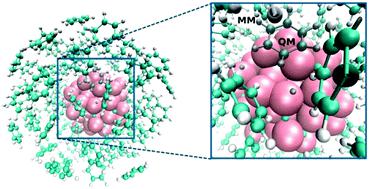当前位置:
X-MOL 学术
›
Phys. Chem. Chem. Phys.
›
论文详情
Our official English website, www.x-mol.net, welcomes your
feedback! (Note: you will need to create a separate account there.)
Multiscale molecular modelling: from electronic structure to dynamics of nanosystems and beyond
Physical Chemistry Chemical Physics ( IF 2.9 ) Pub Date : 2022-04-01 , DOI: 10.1039/d1cp05928a Dennis R Salahub 1
Physical Chemistry Chemical Physics ( IF 2.9 ) Pub Date : 2022-04-01 , DOI: 10.1039/d1cp05928a Dennis R Salahub 1
Affiliation

|
Important contemporary biological and materials problems often depend on interactions that span orders of magnitude differences in spatial and temporal dimensions. This Tutorial Review attempts to provide an introduction to such fascinating problems through a series of case studies, aimed at beginning researchers, graduate students, postdocs and more senior colleagues who are changing direction to focus on multiscale aspects of their research. The choice of specific examples is highly personal, with examples either chosen from our own work or outstanding multiscale efforts from the literature. I start with various embedding schemes, as exemplified by polarizable continuum models, 3-D RISM, molecular DFT and frozen-density embedding. Next, QM/MM (quantum mechanical/molecular mechanical) techniques are the workhorse of pm-to-nm/ps-to-ns simulations; examples are drawn from enzymes and from nanocatalysis for oil-sands upgrading. Using polarizable force-fields in the QM/MM framework represents a burgeoning subfield; with examples from ion channels and electron dynamics in molecules subject to strong external fields, probing the atto-second dynamics of the electrons with RT-TDDFT (real-time – time-dependent density functional theory) eventually coupled with nuclear motion through the Ehrenfest approximation. This is followed by a section on coarse graining, bridging dimensions from atoms to cells. The penultimate chapter gives a quick overview of multiscale approaches that extend into the meso- and macro-scales, building on atomistic and coarse-grained techniques to enter the world of materials engineering, on the one hand, and cell biology, on the other. A final chapter gives just a glimpse of the burgeoning impact of machine learning on the structure-dynamics front. I aim to capture the excitement of contemporary leading-edge breakthroughs in the description of physico-chemical systems and processes in complex environments, with only enough historical content to provide context and aid the next generation of methodological development. While I aim also for a clear description of the essence of methodological breakthroughs, equations are kept to a minimum and detailed formalism and implementation details are left to the references. My approach is very selective (case studies) rather than exhaustive. I think that these case studies should provide fodder to build as complete a reference tree on multiscale modelling as the reader may wish, through forward and backward citation analysis. I hope that my choices of cases will excite interest in newcomers and help to fuel the growth of multiscale modelling in general.
中文翻译:

多尺度分子建模:从电子结构到纳米系统动力学及其他
重要的当代生物和材料问题通常取决于跨越空间和时间维度上数量级差异的相互作用。本教程回顾试图通过一系列案例研究来介绍这些引人入胜的问题,目标是初级研究人员、研究生、博士后和更资深的同事,他们正在改变方向,专注于他们研究的多尺度方面。具体示例的选择是高度个人化的,示例要么来自我们自己的工作,要么来自文献中出色的多尺度努力。我从各种嵌入方案开始,例如极化连续模型、3-D RISM、分子 DFT 和冷冻密度嵌入。接下来,QM/MM(量子力学/分子力学)技术是 pm-to-nm/ps-to-ns 模拟的主力;例子来自酶和用于油砂提质的纳米催化。在 QM/MM 框架中使用极化力场代表了一个新兴的子领域;以受强外场影响的分子中的离子通道和电子动力学为例,用 RT-TDDFT(实时 - 时间相关密度泛函理论)探索电子的阿秒动力学,最终通过 Ehrenfest 近似与核运动相结合. 接下来是关于粗粒度的部分,将尺寸从原子连接到细胞。倒数第二章简要概述了扩展到中观和宏观尺度的多尺度方法,这些方法建立在原子和粗粒度技术的基础上,一方面进入材料工程领域,另一方面进入细胞生物学领域。最后一章简要介绍了机器学习对结构动力学前沿的迅速影响。我的目标是捕捉当代在复杂环境中描述物理化学系统和过程的前沿突破所带来的兴奋,只有足够的历史内容来提供背景并帮助下一代方法学的发展。虽然我的目标也是对方法学突破的本质进行清晰的描述,但将方程式保持在最低限度,并将详细的形式主义和实施细节留给参考文献。我的方法非常有选择性(案例研究),而不是详尽无遗。我认为这些案例研究应该提供素材,通过前向和后向引文分析,为读者构建一个完整的多尺度建模参考树。
更新日期:2022-04-01
中文翻译:

多尺度分子建模:从电子结构到纳米系统动力学及其他
重要的当代生物和材料问题通常取决于跨越空间和时间维度上数量级差异的相互作用。本教程回顾试图通过一系列案例研究来介绍这些引人入胜的问题,目标是初级研究人员、研究生、博士后和更资深的同事,他们正在改变方向,专注于他们研究的多尺度方面。具体示例的选择是高度个人化的,示例要么来自我们自己的工作,要么来自文献中出色的多尺度努力。我从各种嵌入方案开始,例如极化连续模型、3-D RISM、分子 DFT 和冷冻密度嵌入。接下来,QM/MM(量子力学/分子力学)技术是 pm-to-nm/ps-to-ns 模拟的主力;例子来自酶和用于油砂提质的纳米催化。在 QM/MM 框架中使用极化力场代表了一个新兴的子领域;以受强外场影响的分子中的离子通道和电子动力学为例,用 RT-TDDFT(实时 - 时间相关密度泛函理论)探索电子的阿秒动力学,最终通过 Ehrenfest 近似与核运动相结合. 接下来是关于粗粒度的部分,将尺寸从原子连接到细胞。倒数第二章简要概述了扩展到中观和宏观尺度的多尺度方法,这些方法建立在原子和粗粒度技术的基础上,一方面进入材料工程领域,另一方面进入细胞生物学领域。最后一章简要介绍了机器学习对结构动力学前沿的迅速影响。我的目标是捕捉当代在复杂环境中描述物理化学系统和过程的前沿突破所带来的兴奋,只有足够的历史内容来提供背景并帮助下一代方法学的发展。虽然我的目标也是对方法学突破的本质进行清晰的描述,但将方程式保持在最低限度,并将详细的形式主义和实施细节留给参考文献。我的方法非常有选择性(案例研究),而不是详尽无遗。我认为这些案例研究应该提供素材,通过前向和后向引文分析,为读者构建一个完整的多尺度建模参考树。
















































 京公网安备 11010802027423号
京公网安备 11010802027423号